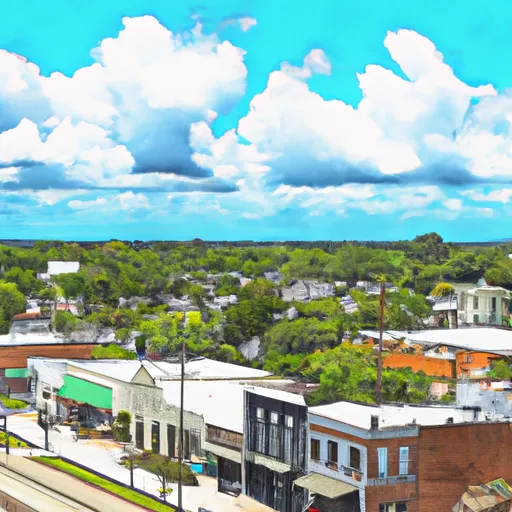-
 Snoflo Premium
Snoflo Premium
Get unlimited access to all our content
With no Ad interruptions! - Start Your Free Trial Login with existing account
Hollister
Eden Index
Climate
7.3
•
Recreation
6.6
•
Community
•
Safeguard
5.2/10

Hollister, Florida is a small town located in Putnam County. It experiences a humid subtropical climate with hot, humid summers and mild, dry winters. Summers are characterized by temperatures ranging from the mid-80s to low 90s°F, while winters see temperatures in the mid-60s to low 70s°F. The area receives ample rainfall throughout the year, with the wettest months occurring from June to September.
Hollister is surrounded by various hydrology constituents, including lakes, ponds, and streams. Nearby Lake Santa Fe, a 5,850-acre lake, offers excellent fishing and boating opportunities. The lake is known for its abundance of largemouth bass, catfish, and bream. Additionally, the Ocklawaha River flows nearby, providing opportunities for kayaking, canoeing, and wildlife viewing.
Outdoor recreation enthusiasts in Hollister can explore the Ocala National Forest, which is just a short drive away. The forest offers an array of activities such as hiking, camping, horseback riding, and off-road biking. With its diverse ecosystems and scenic trails, the Ocala National Forest provides an excellent backdrop for nature lovers and adventure seekers alike.
In summary, Hollister, Florida offers a humid subtropical climate, abundant hydrology constituents, and numerous outdoor recreation opportunities, making it an attractive destination for those seeking nature-oriented activities.
What is the Eden Index?
The Snoflo Eden Index serves as a comprehensive rating system for regions, evaluating their desirability through a holistic assessment of climate health, outdoor recreation opportunities, and natural disaster risk, acknowledging the profound impact of these factors on livability and well-being.
Climate Health Indicator (CHI): 7.3
Hollister receives approximately
1318mm of rain per year,
with humidity levels near 89%
and air temperatures averaging around
21°C.
Hollister has a plant hardyness factor of
9, meaning
plants and agriculture in this region tend to thrive here all year round.
By considering the ideal temperature range, reliable water supplies, clean air, and stable seasonal rain or snowpacks, the Climate Health Indicator (CHI) underscores the significance of a healthy climate as the foundation for quality living.
A healthy climate is paramount for ensuring a high quality of life and livability in a region, fostering both physical well-being and environmental harmony. This can be characterized by ideal temperatures, reliable access to water supplies, clean air, and consistent seasonal rain or snowpacks.
Weather Forecast
Streamflow Conditions
St. Johns
Area Rivers
St. Johns
Snowpack Depths
St. Johns
Reservoir Storage Capacity
St. Johns
Groundwater Levels
Recreational Opportunity Index (ROI): 6.6
The Recreational Opportunity Index (ROI) recognizes the value of outdoor recreational options, such as parks, hiking trails, camping sites, and fishing spots, while acknowledging that climate plays a pivotal role in ensuring the comfort and consistency of these experiences.
Access to outdoor recreational opportunities, encompassing activities such as parks, hiking, camping, and fishing, is crucial for overall well-being, and the climate plays a pivotal role in enabling and enhancing these experiences, ensuring that individuals can engage in nature-based activities comfortably and consistently.
Camping Areas
| Campground | Campsites | Reservations | Toilets | Showers | Elevation |
|---|---|---|---|---|---|
| Shanty Pond Recreation Area | 120 | 34 ft | |||
| Hopkins Prairie | 21 | 35 ft | |||
| Lake Louisa State Park | None | 154 ft | |||
| Salt Springs | 267 | 26 ft | |||
| Fore Lake | 100 | 82 ft | |||
| Lake Griffin State Rec Area | None | 85 ft | |||
| Big Scrub | 50 | 145 ft | |||
| Big Bass | 34 | 69 ft | |||
| Trimble County Park | 15 | 65 ft | |||
| Gores Landing County Park | None | 31 ft |
Catastrophe Safeguard Index (CSI):
The Catastrophe Safeguard Index (CSI) recognizes that natural disaster risk, encompassing floods, fires, hurricanes, and tornadoes, can drastically affect safety and the overall appeal of an area.
The level of natural disaster risk in a region significantly affects safety and the overall livability, with climate change amplifying these risks by potentially increasing the frequency and intensity of events like floods, fires, hurricanes, and tornadoes, thereby posing substantial challenges to community resilience and well-being.
Community Resilience Indicator (CRI):
The Community Resilience Indicator (CRI) recognizes that education, healthcare, and socioeconomics are crucial to the well-being of a region. The CRI acknowledges the profound impact of these elements on residents' overall quality of life. By evaluating educational resources, healthcare accessibility, and economic inclusivity, the index captures the essential aspects that contribute to a thriving community, fostering resident satisfaction, equity, and social cohesion.

